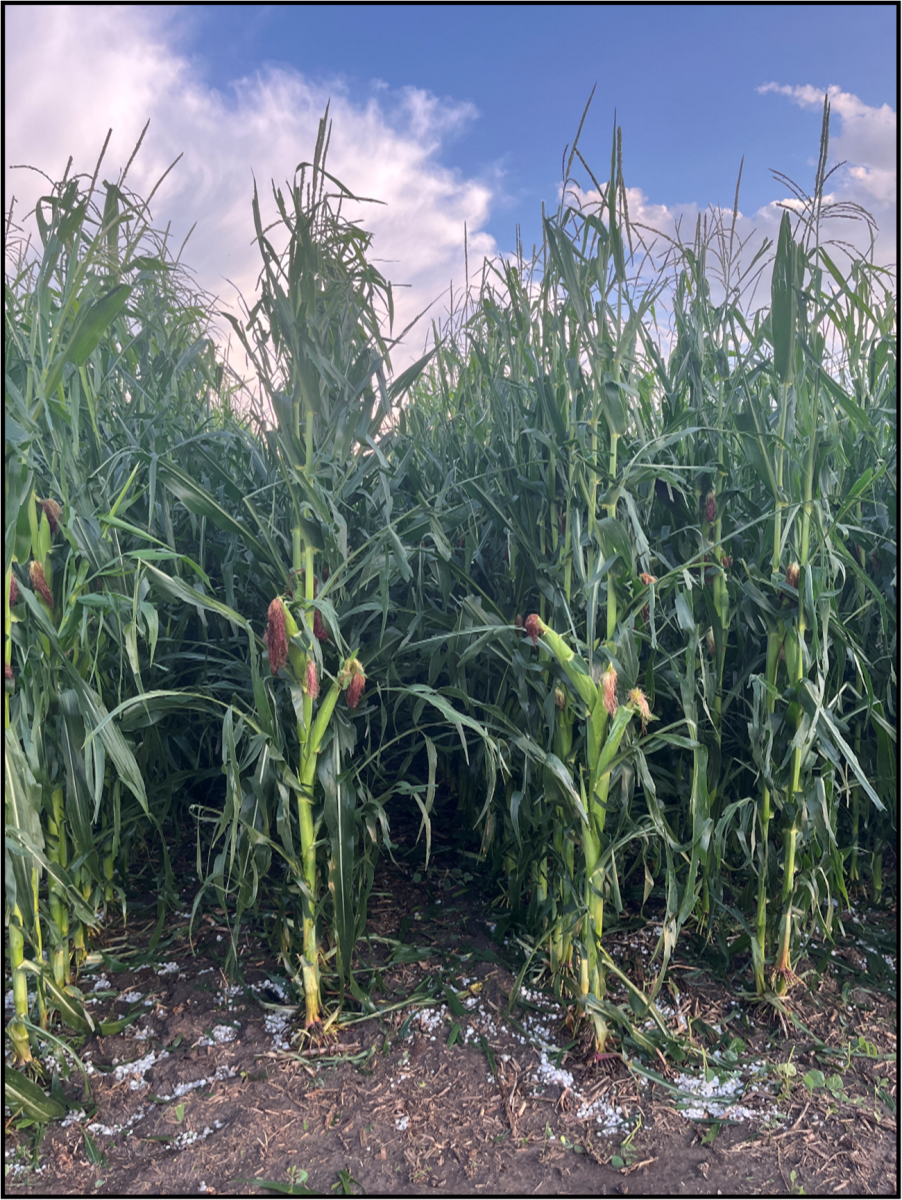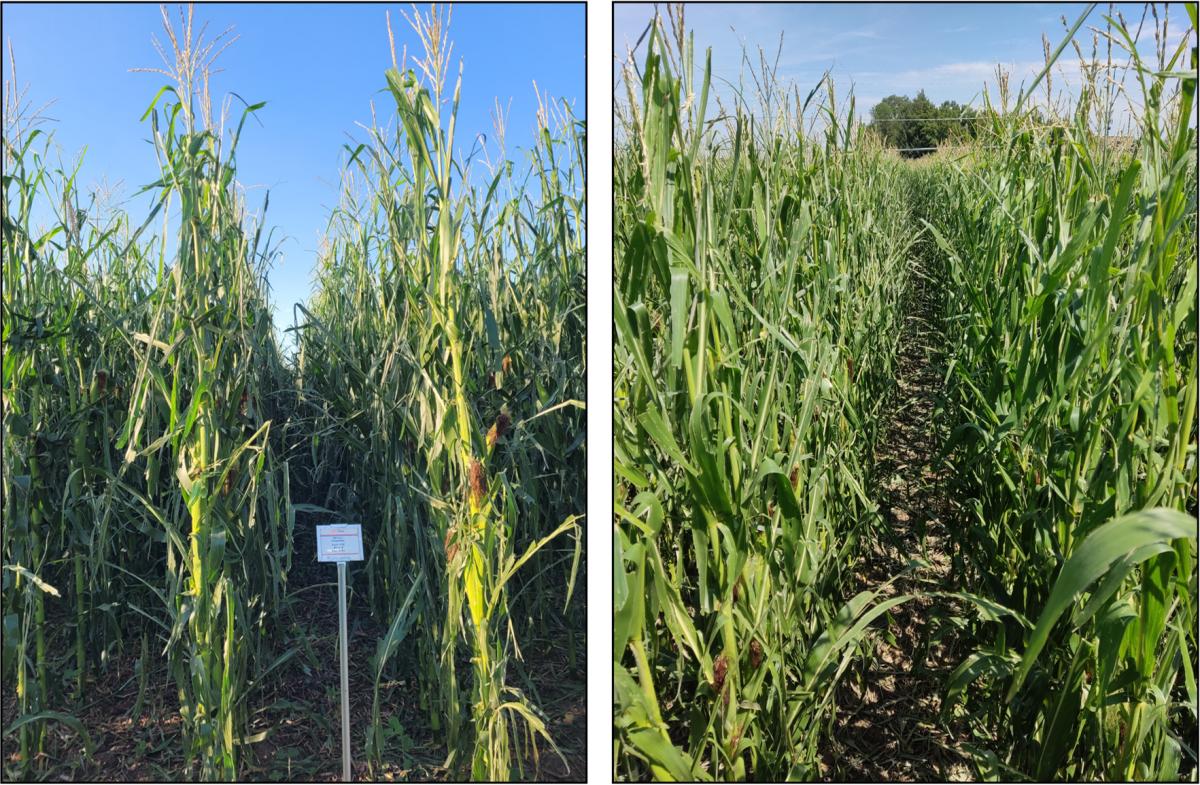By: Krystle Rhoades, TAPS Program Manager
On Saturday, July 22nd a severe thunderstorm moved through the North Platte, Neb. area. For the first time in the Testing Ag Performance Solutions (TAPS) seven-year history, the storm’s wrath battered the farm management competition plots.
National Weather Service in North Platte reported 59 MPH winds at their office east of town and had other locations throughout town that reported up to 70 MPH winds with the storm. Along with the winds, the storm carried with it hail and although the hail wasn’t large in diameter, combined with the wind it was enough to affect the TAPS sprinkler corn, popcorn and subsurface drip irrigated (SDI) corn fields located on the south edge of North Platte at the West Central Research, Extension & Education Center (WCREEC).
According to the University of Nebraska’s Extension Circular “Evaluating Hail Damage to Corn” (EC126), hail affects corn yields in three ways: plant stand reductions, direct damage, and leaf defoliation. Defoliation was the main damage found in all three competition fields, although there were some stalks broken over especially in the popcorn competition.

Photo taken of the SDI corn competition plots shortly after the storm passed. Photo by Milos Zaric & Andrea Rilakovic.
To determine yield loss due to defoliation, EC126 suggests the following steps: 1. Establish the plant growth stage at the time of storm; 2. Estimate percent of leaf defoliation; 3. Use provided “Table III” to predict yield reduction from defoliation.
With those steps in mind the TAPS team has determined that the TAPS sprinkler and SDI corn fields were averaging R1-R2 growth stage at the time of the weather event. Leaf Area Index (LAI) measurements were collected the week prior to the storm in an adjacent study located on the same variable rate irrigation sprinkler system. The adjacent study had similar crop growth conditions with resulting values of 4.4 ft2 ft2. The same data was collected on this research area following the storm with new values of 2.9 ft2 ft2. LAI is the ratio of one-sided leaf area per unit of ground area and is used to quantify the amount of leaf material in a canopy. Therefore, it is estimated that there was approximately 35-50% leaf defoliation. Consequently, the estimated percent of corn yield loss is from 17-31%.
The popcorn competition was approximately one growth stage behind the other corn competitions and is estimated to have a similar yield loss range.

Photos taken Monday, July 24th following the storm. Left shows one of the popcorn competition plots and at right is one of the sprinkler corn competition plots. Photos taken by Krystle Rhoades.
The TAPS competitors are required to carry at least 65% multi-peril crop insurance, but no hail or wind insurance is offered. Therefore, there will be no insurance payment based on the hail damage, instead any indemnity payments will be based off the final yields at harvest along with the type and level of insurance coverage the participant selected at the beginning of the year.
As for management decisions, competitors are still afforded the opportunity to apply late-season nitrogen fertilizer via fertigation, as well as irrigate on Mondays and Thursdays.
The only management decision that was affected by the storm damage was the insecticide decision in SDI corn. Dr. Julie Peterson and her team scouted for Western Bean Cutworms on Friday, July 21st and found 2-3% infestation in the SDI plots. Following the weather event, it was the TAPS team's decision to cancel the insecticide decisions due to the low pre-storm infestation rate and an expected decrease in egg masses due to leaf damage.
Hail damage to row crops can occur at any time during the growing season. "You can’t prevent hail, but it is critical that you assess the extent of damage to determine the best management practices for the remainder of the growing season," Justin McMechan, UNL Crop Protection & Cropping Systems Specialist commented. HailKnow, a product of the University of Nebraska - Lincoln, is a one-stop shop for making informed and timely decisions after a hailstorm. The website walks you through the process with videos and quick infographics that provide information on the hailstorm, assessing plant damage, handling insurance, and managing a recovering crop.
“As with most producers that receive hail damage, the UNL-TAPS team is considering learning opportunities after the storm such as reduced water use due to leaf loss and possibly inter-seeding cover crops since the canopy has been opened up,” Chuck Burr, Water & Cropping Systems Specialist and TAPS Team Member, commented.